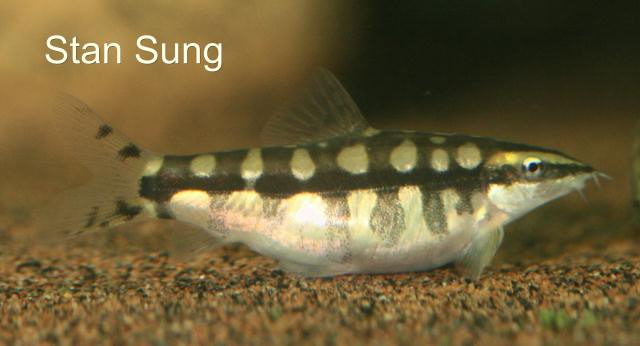 Ambastaia sidthimunki is known by a variety of names in the trade (all of which are easier to pronounce and spell than their mile-long Latin name!). Chipmunk loach, dwarf chain loach, pygmy loach, and Sid the monkey are all names given to these delightfully active and entertaining fish.
Ambastaia sidthimunki is known by a variety of names in the trade (all of which are easier to pronounce and spell than their mile-long Latin name!). Chipmunk loach, dwarf chain loach, pygmy loach, and Sid the monkey are all names given to these delightfully active and entertaining fish.
The natural range of this species is from the Mekong and Chao Phraya river basins in Thailand, Laos, and Cambodia. Rumored to be extinct in the wild, and critically endangered at best, aquarists with a penchant for small, playful fishes are urged to keep a colony of A. sidthimunki among their collections. Their captive environment should mimic the shallow, flowing rivers that they once dwelled in. An aquarium of at least 20 gallons, furnished with sand substrate, river rock, and pebble décor, will suit these little loaches swimmingly. Plenty of aeration and filtration via either power filters or powerheads with a strong water return should be implemented to create a current simulating the natural pull of the river.

Mature female Yasuhikotakia sidthimunki are easily identified by their swollen bellies. If the link can be found to trigger spawning, there is no reason why this ripe female will not breed in aquaria.
These loaches (or any other member of the genus Ambastaia) have never been bred in aquaria. Commercial fish farms in the East have succeeded in breeding these fish using hormone treatments, but as of yet this species has eluded propagation in the home aquarium. This comes as a surprise as A. sidthimunki are easily sexed when mature (with the adult females appearing much plumper in appearance than the slimmer males). This is a very durable aquarium subject and because of the small adult size of only 2.5 inches in length, this Ambastaia sp. is one of the leading candidates to be successfully spawned and reared by hobbyists.
Some loaches that are found in the trade breed sporadically in captivity. The aquarist only finds that a spawning has occurred when fry are found during routine tank maintenance! This being said, it would be wise to house prospective breeders in a species-only aquarium with many layers of stones and rocks in which potential fry can hide. These sociable little creatures should be kept in groups of eight or more. Although spawning in the home aquarium is the goal to strive for, even without breeding success these interesting and highly entertaining charges are a joy to keep.
